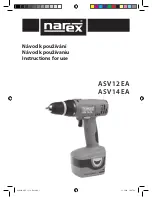
CHAPTER 4: CONTROLS
MODEL HF2 2 kHz HIGH FREQUENCY RESISTANCE WELDING POWER SUPPLY
4-10
990-057
Control Signals - Process Inhibit Input (Figure 4-8)
Connect a reed relay, or the open collector of an opto coupler to Pin 9 of the Control Signals connector
to prevent a new welding process from beginning. No welding process can be initiated until the switch
closure has been removed. The emitter of the opto coupler must be connected to Pin 11.
Control Signals - Output Relays (Figure 4-8)
There are two output relays which can be used to provide status or timing signals to a user
Programmable Logic Control (PLC) or Host Computer. Relay K1 can switch a 24 to 115 VAC signal.
Relay K2 can switch a 5 to 50 VDC signal. When used for status signals, these relays can be
independently programmed to close (a) when the HF2 Weld Control is initiated; (b) when any portion of
the welding process is completed; (c) when the Firing Switch opens; or (d) when the HF2 Weld Control
is waiting for the welding process sequence to start.
Relay K1 (Figure 4-10)
1
Connect a 24 to 115 VAC voltage
source and PLC load to Pins 8 and 15
on the Control Signals Connector.
Maximum relay current is limited to
250 ma.
2
Relay K1 is also used to control the Air
Valve 2 Driver for sequentially
activating a second Air Actuated Weld
Head. Refer to
Chapter 3, Unitek Peco,
Force Fired, Dual Air Actuated Weld
Head System
for complete instructions
to set up and operate two sequential
action Air
Figure 4-10. Relay K and K2 Connections
Actuated Weld Heads. When MENU, OPTIONS 2, WELD HEAD TYPE: is set to DUAL
AIR, the options for RELAY 1 must be either AIR HEAD 2 or NOT USED. Air Valve 2
Driver will be actuated in any Schedule in which RELAY 1 is defined as AIR HEAD 2. Air
Valve 1 Driver is actuated in any Schedule in which RELAY 1 is defined as NOT USED.
Relay K2 (Figure 4-10)
Connect a 5 to 50 VDC voltage source and PLC load to Pins 6 (Positive) and 13 (Negative) on the
Control Signals Connector. Maximum relay current is limited to 250 ma.
Accessory Port (Figure 4-2)
A 25-pin, sub-miniature D-type connector, located on the rear panel, is provided to control other
devices contemplated for future expansion.
















































